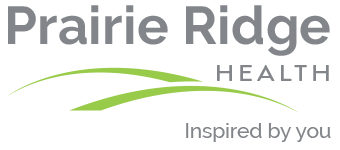Prepare for disaster - one step at a time
For most of us, when crisis hits, we look to those in healthcare, police and fire, emergency medical services, and our local utilities to handle the problem. But in the event of a disaster, being dependent on others may not be the first line of defense in keeping ourselves and our loved ones safe.
Karen Sell, RN, has served as the Emergency Preparedness Chairperson at Prairie Ridge Health for the past 20 years. Sell urges community members to take the proper steps to prepare themselves for loss of water, power, heat, shelter, and communication, when disasters happen.
“In a disaster, 911 will prioritize calls,” said Sell. “There may be trees down, roads blocked, and it could be days before anyone can move or get to you. Those services we take for granted every day may not be accessible.”
Sell serves as the secretary for the Columbus/Fall River Preparedness Group and is a member of the Region 5 Healthcare Coalition, which includes representatives from healthcare, police, fire, EMS, emergency managers, and public health. “We share ideas and develop an understanding of what each department or agency does in a disaster situation. Everyone then knows what their place is in an emergency,” explained Sell.
“Developing a disaster plan for your family is not much different,” said Sell. “You are identifying the resources you need and responsibilities you will have in a disaster.”
Sell encourages community members and businesses to visit Do1Thing.com. Do 1 Thing is a non-profit organization that wants to help build stronger communities. When community members are prepared, emergency responders can help more people. When people are prepared themselves, they can help their neighbors. The website offers a 12-step program, with one step to complete each month, in an effort to prepare individuals, businesses, and communities for all hazards and to become disaster resilient.
“If you do these things to prepare, when you have to respond, you are going to know what you need to do,” said Sell. “And it’s manageable. Even if you aren’t able to complete all 12 items, if you can do just six of the 12, you are off to a good start.”
For the month of March, Do1Thing.com offers this step:
SHELTERING
Identify the best storm shelter in your home and practice getting to shelter with your family.
Choosing the best place in your home or workplace to shelter from a tornado isn’t always easy. Many newer buildings don’t have a really good shelter area. Use these rules of thumb to find the best tornado shelter possible:
• Stay away from windows and skylights
• Shelter “down and in” - Put as many walls between yourself and the outside as you can (think of the ceiling as a wall)
• Avoid rooms with large ceiling expanses
• Find an area large enough for everyone to stay comfortably for at least 45 minutes
If you live in an area prone to hurricanes, be prepared to protect your family and your property. Cover windows with plywood or hurricane shutters when a hurricane warning is issued—don’t use tape. If you are advised to evacuate, do so. Otherwise, stay inside and away from windows until the storm has completely passed.
Learn how to safely shelter in place.
In an emergency like a chemical spill, you may be told to “shelter in place”. This means to make the place where you are a safe place to stay until the danger has passed. Shelter in place orders are given when it would be dangerous for you to go outside.
Notification - Warning sirens may be used to warn people that it is not safe to be outside. Emergency responders may go door to door in the affected area. They may also use loudspeakers from police or fire vehicles to give instructions. Information will also be given over television and radio using the Emergency Alert System.
What to do in a hazardous materials incident - The first thing to do when a chemical spill or similar event occurs is to get information. Turn on the television or radio to find out if your area is affected and what steps to take. Never call 911 to get information about an emergency. Only call 911 if you are injured or need assistance.
If you are told to shelter in place you should close all doors and windows and shut off fans and air conditioners. Take your family to a room with as few doors and windows as possible. You may be told to put towels or tape around the cracks of the windows and doors. Follow emergency instructions carefully. Make sure you take a battery-powered radio with you so that you will know when the danger has passed. Power in your area may be shut off during the incident.
Make a Go Bag for emergency sheltering.
Emergency shelters will be opened when people are displaced from their homes. In most areas emergency shelters are operated by the American Red Cross. At the Red Cross Shelter:
Red Cross will provide
• A cot to sleep on
• Meals and bottled water
• A nurse for basic medical care
• Information about the disaster from public officials
You may need to bring
• Pillow and blanket
• Your own medication and medical supplies (or a list of what you are taking, dosage, and Dr’s names)
• Identification
• Change of clothes
• Cards or magazines
• Comfort items
Not allowed at the shelter
• Weapons or alcohol
• Pets (except for service animals)
Inspire Magazine, in cooperation with Prairie Ridge Health and Do1Thing.com, will publish one disaster step each month in order to prepare you for a disaster. For questions, please visit Do1Thing.com, or contact Sell at ksell@prairieridge.health.

